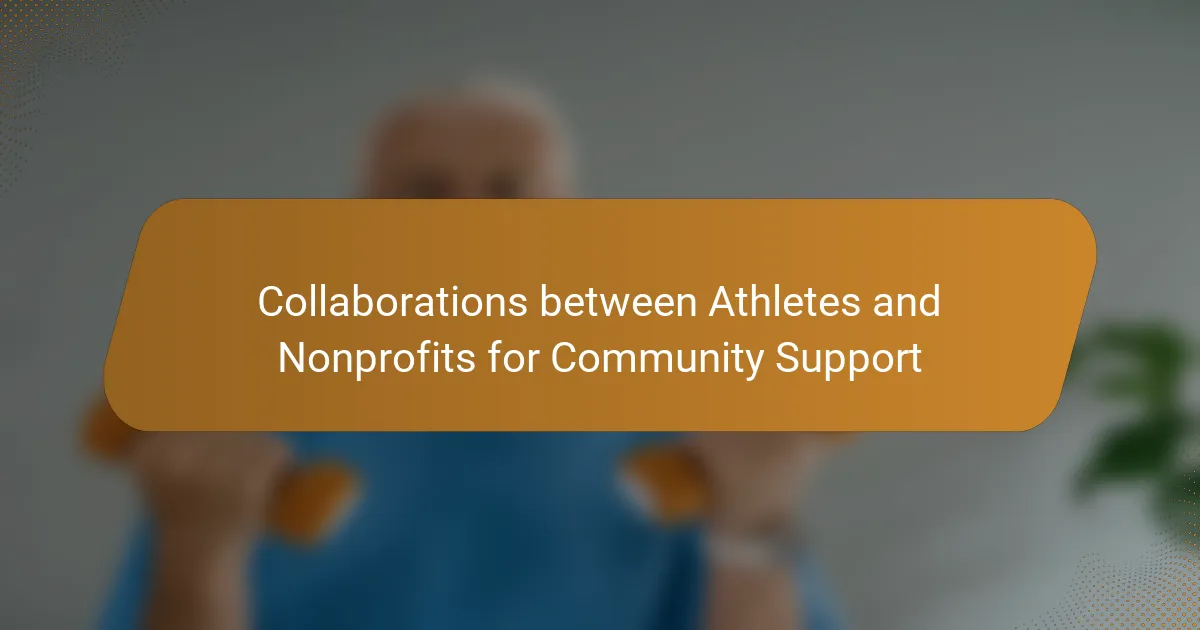Collaborations between athletes and nonprofits significantly enhance community support by raising awareness, mobilizing resources, and engaging local populations. These partnerships often involve fundraising events, mentorship programs, and health initiatives. Athletes leverage their visibility to drive social change, while nonprofits gain access to wider audiences and funding opportunities. Together, they address critical issues like education, health, and social justice, fostering stronger community ties.
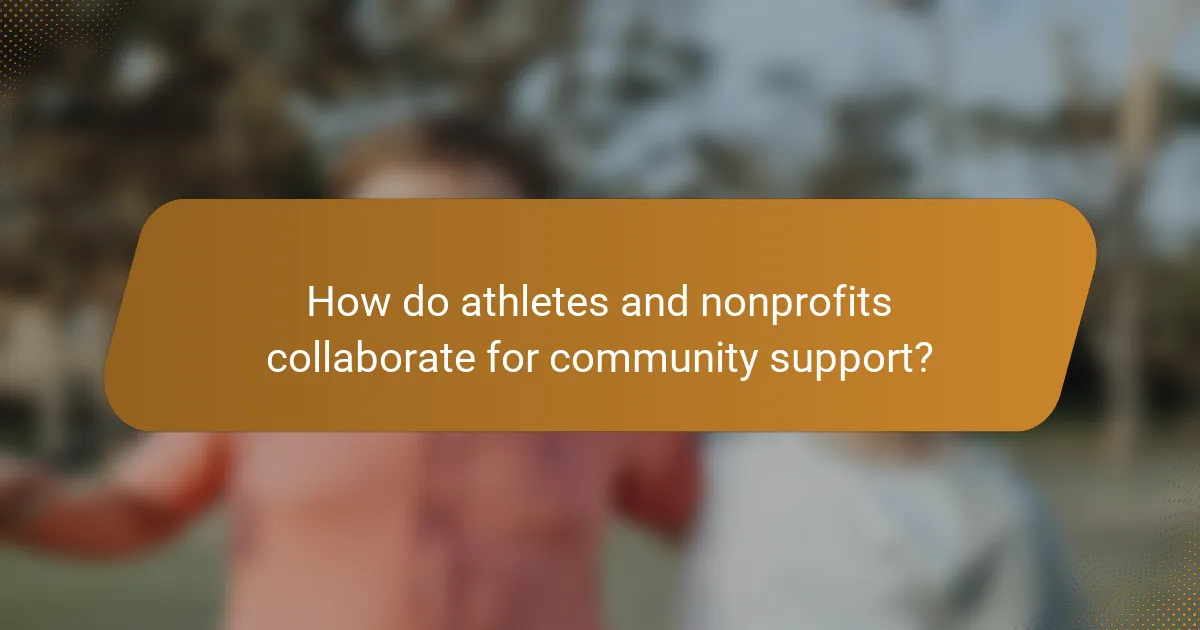
How do athletes and nonprofits collaborate for community support?
Athletes and nonprofits collaborate to enhance community support through fundraising, awareness campaigns, and mentorship programs. These partnerships leverage athletes’ visibility to drive social change and mobilize resources for local needs.
For example, athletes often participate in charity events, donating their time and influence to attract donations. Nonprofits benefit from this exposure, gaining access to wider audiences and increased funding opportunities.
Such collaborations also foster community engagement, as athletes serve as role models, inspiring youth to participate in sports and community service. This unique attribute of athlete involvement can lead to long-term benefits for both the community and the organizations.
As a result, these partnerships create a positive impact, addressing issues like education, health, and social justice, ultimately strengthening community ties.
What are the common goals of these collaborations?
The common goals of collaborations between athletes and nonprofits for community support include raising awareness, promoting healthy lifestyles, and providing resources to underserved populations. These partnerships leverage the athletes’ influence to drive engagement and inspire community involvement. Additionally, they aim to foster social responsibility and create lasting positive change through targeted initiatives. Such collaborations often focus on specific causes like youth development, education, and health improvement, enhancing the overall impact on communities.
Which types of nonprofits typically partner with athletes?
Nonprofits that typically partner with athletes include health organizations, youth development programs, environmental groups, and education-focused charities. These collaborations leverage athletes’ influence to promote community causes and raise awareness. Health organizations often focus on fitness and wellness initiatives. Youth development programs aim to inspire and empower young people through sports. Environmental groups utilize athletes to advocate for sustainability and conservation efforts. Education-focused charities seek to enhance access to learning opportunities. Each partnership aligns with the athlete’s values and public persona, maximizing impact.
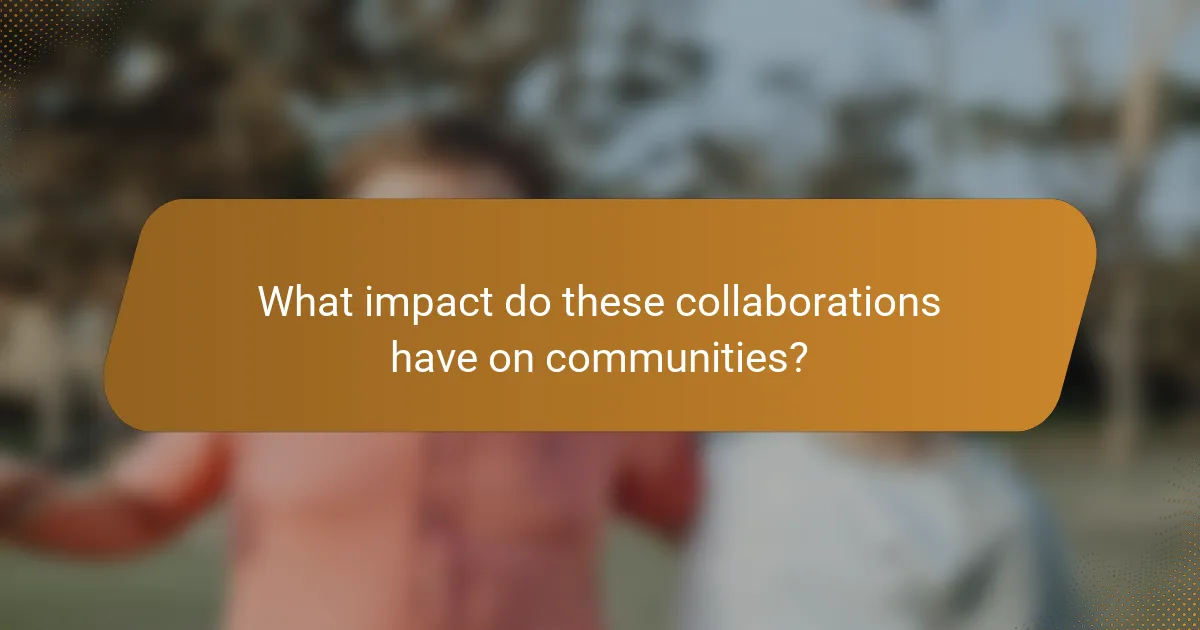
What impact do these collaborations have on communities?
Collaborations between athletes and nonprofits significantly enhance community support. They provide resources, raise awareness, and foster engagement in local issues. For instance, athletes often leverage their platforms to promote health initiatives or educational programs, resulting in increased participation from community members. These partnerships can also lead to substantial financial contributions, directly benefiting local organizations and their missions. As a result, communities experience improved social cohesion and access to vital services, demonstrating the profound impact of such collaborations.
How do success stories illustrate the benefits of athlete-nonprofit partnerships?
Success stories demonstrate that athlete-nonprofit partnerships effectively drive community support and engagement. These collaborations often lead to increased awareness and resources for important causes. For instance, athletes can leverage their platforms to promote nonprofit initiatives, resulting in higher donations and volunteer participation. Additionally, these partnerships foster a sense of community, inspiring others to contribute and create positive change. The unique visibility athletes provide enhances the nonprofit’s reach and impact, showcasing the powerful benefits of collaboration.
What metrics are used to measure the effectiveness of these collaborations?
Metrics used to measure the effectiveness of collaborations between athletes and nonprofits include engagement rates, fundraising totals, community impact scores, volunteer hours contributed, social media reach, and participant feedback. These metrics provide insights into the success and reach of the initiatives.
| Metric | Description |
|—————————-|————————————————–|
| Engagement Rates | Measures audience interaction with campaigns |
| Fundraising Totals | Total funds raised for nonprofit initiatives |
| Community Impact Scores | Assessment of positive changes in the community |
| Volunteer Hours Contributed | Total hours athletes spend supporting initiatives |
| Social Media Reach | Number of people reached through social platforms |
| Participant Feedback | Qualitative insights from community members |
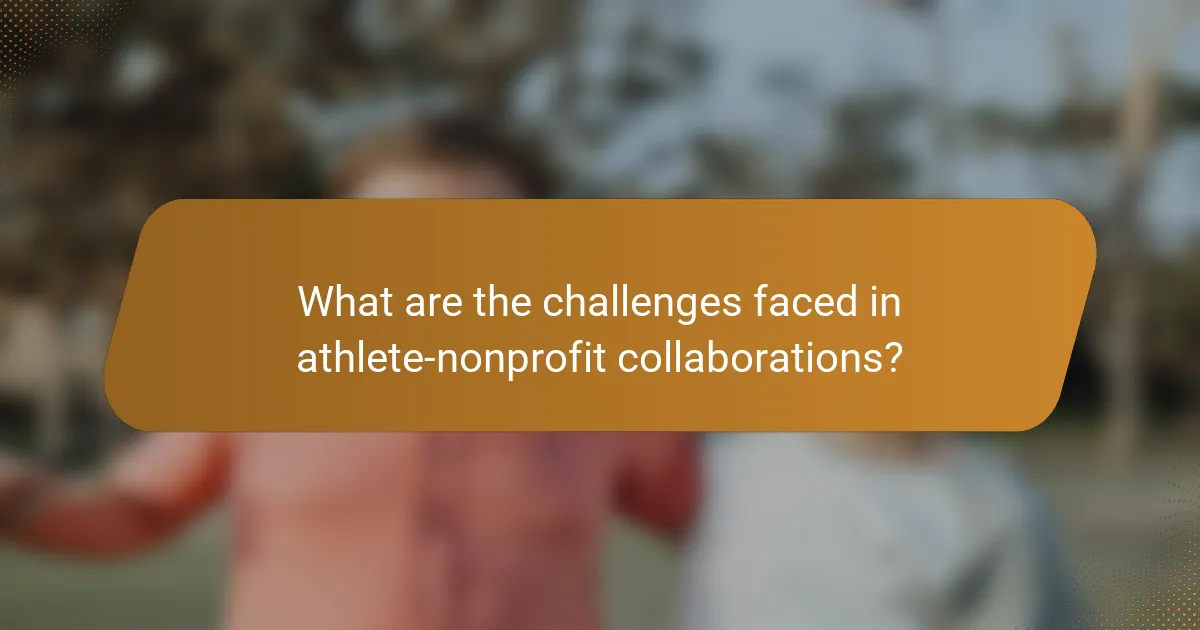
What are the challenges faced in athlete-nonprofit collaborations?
Collaborations between athletes and nonprofits face challenges such as misaligned goals, communication barriers, and resource constraints. Athletes may prioritize personal branding over community impact, leading to conflicts. Nonprofits often struggle to engage athletes effectively, which can hinder project success. Additionally, limited funding and time can restrict collaboration efforts, making it difficult to achieve meaningful outcomes.
How do athletes overcome barriers to engagement with nonprofits?
Athletes overcome barriers to engagement with nonprofits through strategic partnerships and community-focused initiatives. Collaborations often leverage athletes’ visibility to raise awareness and funds for causes. By aligning personal values with nonprofit missions, athletes foster genuine connections that enhance community support. Additionally, athletes use their platforms to inspire fans, encouraging volunteerism and donations. This symbiotic relationship amplifies the impact of nonprofits while providing athletes with a meaningful outlet for their advocacy.
What role does public perception play in these partnerships?
Public perception significantly influences collaborations between athletes and nonprofits. Positive public sentiment enhances visibility and support for these initiatives, driving community engagement. When athletes are viewed favorably, their partnerships with nonprofits gain credibility, attracting more donations and volunteers. Conversely, negative perceptions can hinder these efforts, limiting outreach and impact. This dynamic underscores the importance of athletes maintaining a positive public image to maximize their contributions to community support.
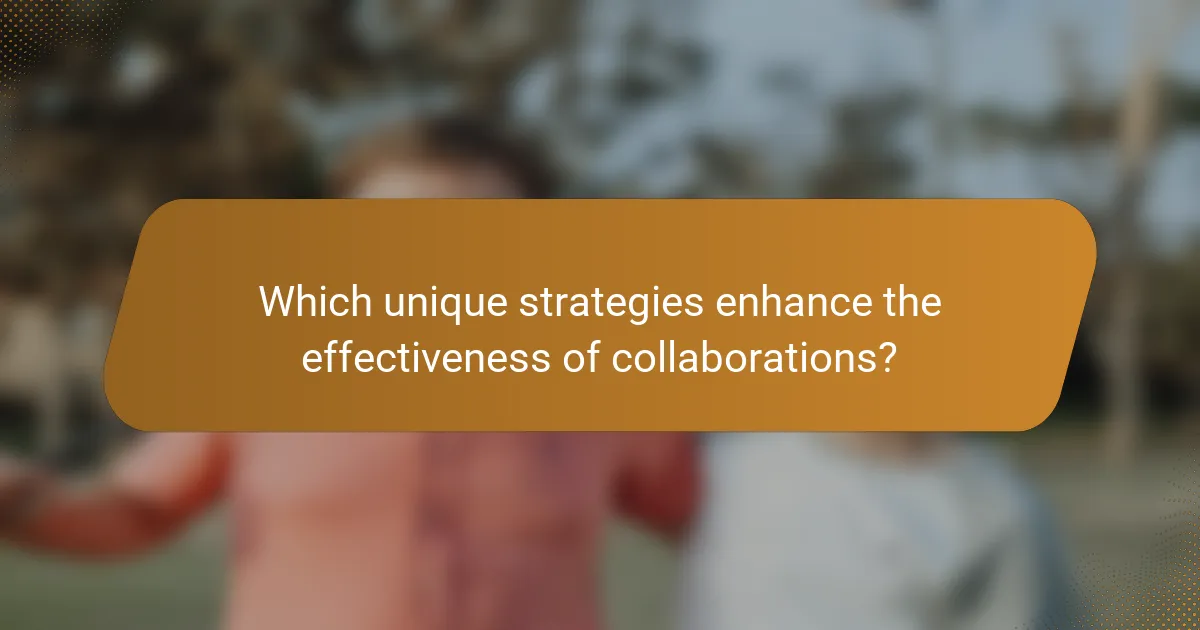
Which unique strategies enhance the effectiveness of collaborations?
Unique strategies that enhance collaborations between athletes and nonprofits include aligning missions, leveraging athlete influence, creating engaging events, and fostering community involvement. These approaches amplify impact and ensure sustainable support.
Aligning missions ensures both parties share common goals, enhancing collaboration effectiveness. Leveraging athlete influence allows nonprofits to reach wider audiences, increasing awareness and support. Engaging events, such as charity runs or workshops, create memorable experiences that strengthen community ties. Fostering community involvement encourages local participation, building a sense of ownership and commitment to the cause.
How do social media campaigns amplify community support?
Social media campaigns significantly enhance community support through collaborations between athletes and nonprofits. These partnerships leverage athletes’ influence to raise awareness and funds for community initiatives. For instance, athletes can share personal stories that resonate with their followers, encouraging them to engage with nonprofit causes. Studies show that campaigns featuring athlete endorsements can increase donations by up to 30%. Moreover, social media allows for real-time interaction, fostering a sense of community among supporters and beneficiaries. This dynamic engagement transforms passive followers into active participants in community support efforts.
What innovative fundraising methods are employed?
Innovative fundraising methods include athlete-led campaigns, social media challenges, and community events. Athletes partner with nonprofits to leverage their influence and engage fans. For example, virtual races and donation drives increase awareness and funds. Collaborative merchandise sales also generate revenue while promoting the cause. These methods enhance community support and foster lasting relationships between athletes and nonprofits.
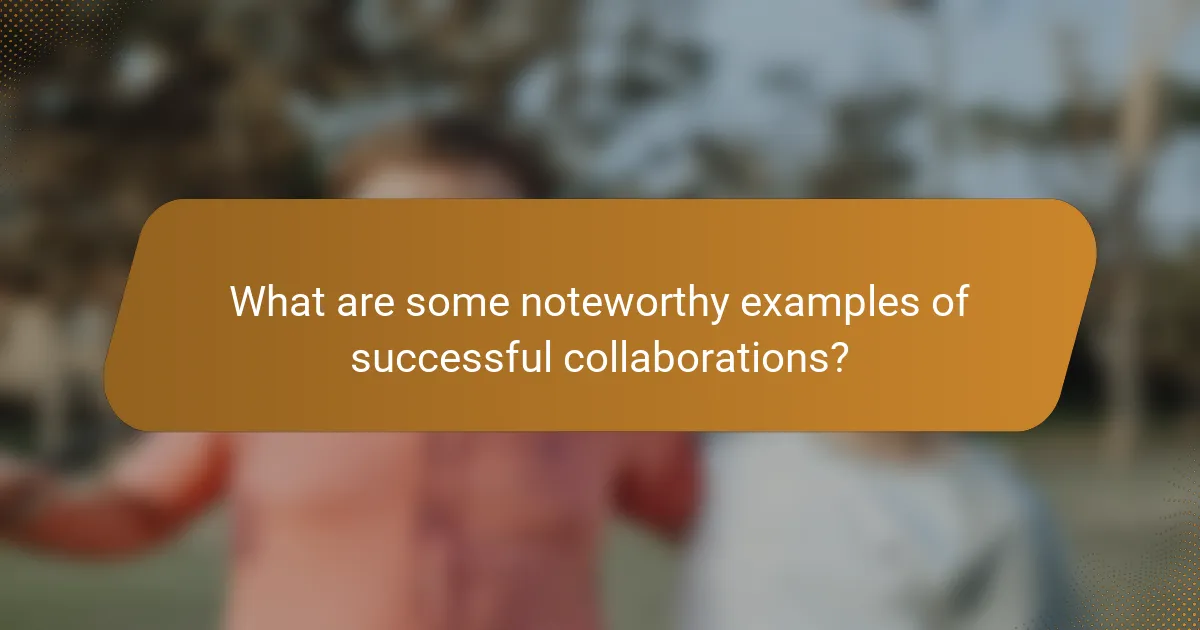
What are some noteworthy examples of successful collaborations?
Collaborations between athletes and nonprofits have led to impactful community support initiatives. Noteworthy examples include:
1. LeBron James and the LeBron James Family Foundation, which focuses on education and youth empowerment.
2. Serena Williams and her work with the Yetunde Price Resource Center, supporting victims of violence.
3. Dwyane Wade partnering with the Wade’s World Foundation, promoting education and health initiatives for underserved communities.
4. Colin Kaepernick’s Know Your Rights Camp, educating youth on their rights and social justice issues.
5. Michael Phelps and his collaboration with the Michael Phelps Foundation, promoting healthy lifestyles and water safety.
Which athletes have made significant impacts through nonprofit work?
Athletes like LeBron James, Serena Williams, and Colin Kaepernick have significantly impacted communities through nonprofit work. LeBron’s “I PROMISE School” focuses on education, while Serena’s “Serena Williams Fund” supports gender equality. Kaepernick’s “Know Your Rights Camp” empowers youth on social justice issues. These collaborations demonstrate the power of sports figures in driving social change.
What lessons can be learned from failed partnerships?
Failed partnerships between athletes and nonprofits highlight critical lessons for future collaborations. Effective communication is essential; misunderstandings can derail initiatives. Clear goals and shared values foster alignment and commitment. Engaging the community throughout the process enhances trust and support. Lastly, evaluating outcomes and feedback allows for continuous improvement and adaptation.
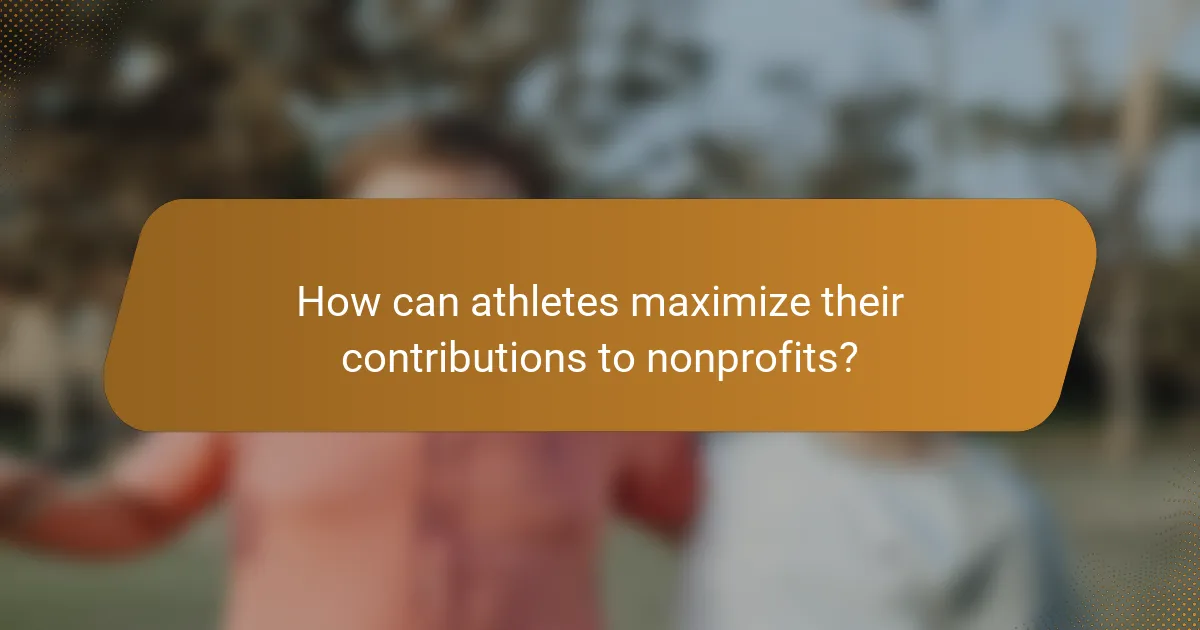
How can athletes maximize their contributions to nonprofits?
Athletes can maximize their contributions to nonprofits by leveraging their visibility and influence. They should engage in collaborative initiatives that align with their values and community needs.
Athletes can participate in fundraising events, raise awareness through social media, and volunteer their time. Forming partnerships with nonprofits allows athletes to amplify their impact. Collaborations can lead to increased resources and community engagement, enhancing both the athlete’s brand and the nonprofit’s mission.
By sharing personal stories and experiences related to the cause, athletes can connect with audiences on a deeper level. This unique attribute of personal connection can drive support and donations, creating a lasting impact.
In addition, athletes can mentor young people, providing guidance and inspiration. This rare attribute of mentorship fosters community development and empowers the next generation.
What best practices should athletes follow when selecting nonprofit partners?
Athletes should prioritize alignment with nonprofit values, assess community impact, and evaluate transparency. Selecting partners who share a mission enhances collaboration effectiveness. Additionally, consider the nonprofit’s track record and community engagement strategies. This ensures a mutually beneficial relationship that maximizes positive outcomes.
Which common mistakes should be avoided in athlete-nonprofit collaborations?
Athlete-nonprofit collaborations should avoid misalignment of goals, lack of communication, insufficient planning, and neglecting community needs. These mistakes can hinder effectiveness and diminish impact.
Misalignment of goals can lead to conflicting priorities, making it difficult to achieve shared objectives. Clear communication is essential; misunderstandings can derail projects. Insufficient planning often results in missed opportunities and wasted resources. Finally, neglecting community needs can alienate the target audience, undermining the collaboration’s purpose.
How can athletes leverage their platforms for greater community impact?
Athletes can significantly enhance community impact by collaborating with nonprofits. These partnerships create awareness, mobilize resources, and foster social change.
Athletes can leverage their influence to amplify nonprofit missions. For instance, they can use social media platforms to promote fundraising campaigns or volunteer initiatives. This visibility often leads to increased donations and community engagement.
Collaborations can also take various forms, such as hosting events or participating in advocacy efforts. These activities allow athletes to connect with their communities on a personal level, demonstrating their commitment to social issues.
Moreover, these partnerships can address unique community needs, such as youth mentorship or health education. By focusing on these rare attributes, athletes can drive meaningful change and inspire others to take action.
